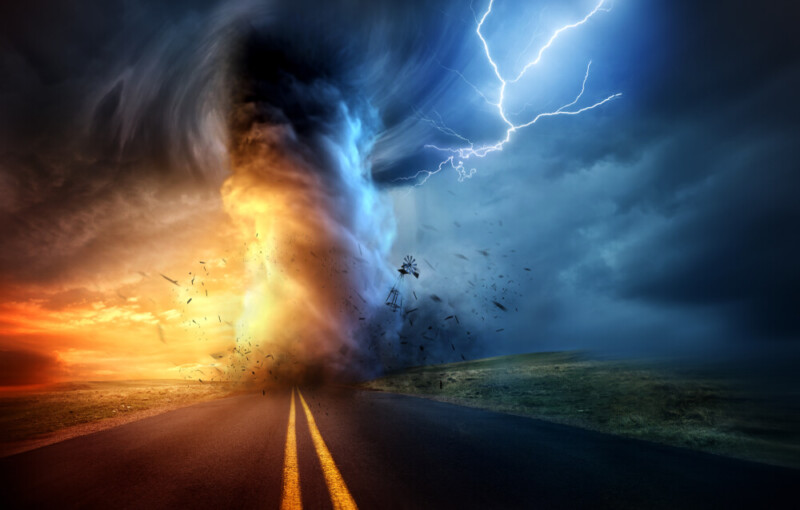It’s National Preparedness Month, and we can never be too prepared! With storm season and weather events only intensifying, it’s a great time to hone those emergency readiness tools. As the saying goes, life is what happens to us while we’re busy making other plans. With higher than average hurricane forecasts for 2020 and the onset of COVID-19, it’s even more important to be ready.
Reports early in the season predicted an above-normal hurricane season, and their predictions have definitely proven to be correct. The most recent forecast by Colorado State University (CSU), published August 5, 2020, predicts a total of 24 named storms (average is 12.1) for the year, of which 12 will become hurricanes (average is 6.4). Of the hurricanes that are expected to occur, 5 will turn into major hurricanes (average is 2.7).
PREPAREDNESS IS KEY
1. Hurricane Season Is Here. Put Your Emergency Plan in Place.
Here in Florida, we all know a thing or two about being ready! Take some time to review your Emergency Plan. Make sure that your plan that is updated per the latest CDC guidelines per COVID-19. Communicate the plan with your family and/or staff members and ensure that everyone is informed. It’s important to know your shelter and evacuation plans. If you’re a business owner, ensure that your staff members, key personnel and vendors are educated on your Business Continuity Plan.
2. Stay Ahead of the Season: Gather Supplies
Make sure you have supplies on hand and stock your Readiness Kit. This is especially important with our supply shortages due to COVID. The empty aisles during the last-minute hurricane supply runs are bad enough! Include enough water, food and necessities in case of a power outage. Check out FEMA’s recommended supplies checklist.
3. Understand Your Insurance Policy, Coverage & Deductibles
It may not be at the top of your to-do list, but it’s always a good time to review your insurance coverage. This simple task can save you a lot of hassle and headache down the road. Know the risk of disasters in your area and what supplemental coverage and policies you may need. Contact your agent if you have questions. Every year, many homeowners realize they’ve purchased inadequate policies and by then, it’s too late. In Florida, everyone should have flood insurance. Standard homeowners policies don’t cover flooding. Flood coverage is provided by the federal government’s National Flood Insurance Program and takes 30 days to take effect. Business owners should also review their policies and ensure adequate coverage is in place.
STORM PREPAREDNESS TIPS
1. Get Routine Property Inspections from a Licensed General Contractor.
A routine inspection should include your roofing, siding, exterior structures, gutters, downspouts, fascia and soffits, windows and doors. We also conduct roofing and building envelope inspections on commercial properties.
2. Tree & Landscaping Recommendations.
To limit flying debris during a storm, it’s important to routinely trim your trees, shrubs, and landscaping here in Florida. This task should be included in your annual hurricane season preparedness and maintenance. Cut back all trees and weak branches that could contact buildings. Thin your foliage so wind can flow freely through branches. This decreases the chance that trees/plants will be uprooted. And first and foremost, when planning your next landscaping project, be sure to buy trees that are adapted to south Florida. These labels include “Florida Fancy” or “Grade #1” trees. These trees have one trunk and need little additional training to form a good quality tree. Trees in Florida thrive in USDA Planting Zone 10.
3. Regularly Clean Your Gutters.
With our heavy rainy season, this simple task is so important! Routinely cleaning your gutters can mitigate further water damage to your roofing, siding and foundations.
4. Fasten & Secure Exterior Structures.
Prior to hurricane and storm season, it’s highly recommended to ensure that all exterior elements including screened pool enclosures, patios, fences, and sheds are sound and secure. This helps prevent them from being uplifted and becoming deadly flying objects in a storm.
5. Strengthen Your Property.
Ensure that you have the appropriate supplies on hand during storm season including shutters or plywood. Your roof, windows, siding, doors and garage doors are all susceptible to extreme wind damage in a hurricane. Remember, the garage door is the most vulnerable part of your home. Make sure it can withstand heavy winds.
Hurricane Preparedness
Hurricane Season in the Atlantic Basin runs from June 1 to November 30 each year, with the most active months here in Florida typically being in September and October. Check out our hurricane preparedness tips if you need a refresher. Know the difference between a Hurricane Watch and Hurricane Warning and what to do in each scenario. Have your communication plan, evacuation plan ready, and be sure to have water, food, supplies, cash, and fuel on hand. Hurricanes can cause major damage including storm surge, wind damage, and flooding. Even areas inland are affected by related storms and potential power outages. Of all recorded weather disasters in U.S. history, hurricanes cause the most deaths and destruction.
Flood Preparedness: Turn Around, Don’t Drown®
According to the National Hurricane Center (NHC), flooding, storm surge, high surf and deaths just offshore within 50 nautical miles of the coast) combined for 88% of all deaths in the U.S. from hurricanes, tropical storms or tropical depressions. Turn around, don’t drown! Know the difference between a Flash Flood Emergency and a Flash Flood Warning and what to do in each scenario. The most common flood deaths occur when a vehicle is driven into hazardous floodwaters. As little as 12 inches of moving floodwater can be enough to make a small vehicle float and carry it away. Just 2 feet of rushing water can sweep away large vehicles, including SUVs and pickup trucks. A mere 6 inches of fast-moving flood water can knock over a full-grown adult. As we saw with Hurricane Sally, the power of storm surge and floods can knock out entire bridges, highways, and roads. And let’s not forget the wildlife that can be lurking in those waters!
Storm Surge Preparedness
Roughly half of all U.S. deaths from tropical cyclones are due to storm surge, which is one of the greatest storm threats to life and property. Surge can be caused by all types of storms including hurricanes, tropical storms, tropical cyclones, and even thunderstorms. If you live in a storm surge evacuation zone, it’s important to know your route and take rapid action when alerted by local officials. Don’t delay if an evacuation is ordered. Storm surge can cut off evacuation routes. Even if your area is not affected by storm surge, remember there are other dangerous hazards to watch out for including downed power lines, water and sewage problems, trees and debris blocking the roads. Downed electrical wires can pose a deadly electrocution risk. Stay safe and remember, what you can’t see can hurt you.
Thunderstorm Preparedness: When Thunder Roars, Go Indoors!
Thunderstorms can include powerful winds over 50 mph, along with the potential for lightning, hail, tornadoes, and flash floods. Be prepared! Know the difference between a Thunderstorm Watch and Thunderstorm Warning and what to do in each scenario. The best defense against thunderstorms is to stay inside a shelter or sturdy building. If indoors, avoid running water or using landline phones. Electricity can travel through plumbing and phone lines. Listen to authorities and weather forecasts for information on whether it is safe to go outside and alerts for potential flash flooding.
Lightning Preparedness
Lightning is one of the most deadly weather hazards in the Sunshine State. Florida sees around 70-100 days a year with at least one thunderstorm, and lightning occurs with every thunderstorm. When possible, avoid the threat when you can. If thunderstorms are expected, cancel or postpone outdoor activities. A good rule of thumb is to remember that if you can hear thunder, you are close enough to be struck by lightning. Even if it is not raining where you are, lightning can still reach you. If you get stuck in a storm, find a sturdy building or stay in a hard-topped vehicle. When inside, stay away from windows and doors. Avoid touching anything plugged in. Lightning can travel through a building’s plumbing during a thunderstorm. Avoid contact with water, including washing dishes and showering.
Tornado Preparedness
Scientists say the old-fashioned term “Tornado Alley” can be misleading, as tornadoes are actually more prevalent in Florida and the South. Tornadoes often accompany hurricanes. Throughout the nation, tornadoes and related storms resulted in approximately $19.5 billion worth of damage in 2019 alone, according to a report by Accuweather. It’s important to know the difference between a Tornado Watch and Tornado Warning, and what to do in each scenario. You may not receive an official alert, so know the warning signs. The wind may die down and the air may become very still (much like being in the eye of a hurricane.) The sky may turn dark or have a greenish hue. You may see approaching clouds of debris, or hear a loud roar similar to the sound of a freight train. Remember, along with the heavy winds it brings, a tornado’s relatives often include lightning and hail. During a tornado, stay in a small, interior, windowless room, preferably on the lowest level or in the basement if you have one. If you have access to a storm shelter or safe room, use it.
Hail Storm Preparedness
Even though hail is not as common in Florida as other parts of the country, it does still occur and you need to be prepared. According to the NOAA, it only takes a wind speed of as little as 58 mph or hail the size of a quarter to cause severe property damage. Be sure to get your property inspected if you think you may have damage. Over 50% of hail claims were made over a year after the hail storm took place, because property owners did not get their roofs inspected. Hail damage often goes undetected, especially in Florida where we least expect it. Don’t wait until it’s too late! According to a study by Aon, hail-related insured losses in the U.S. between 2000 and 2019 averaged between $8 billion to $14 billion a year.
Stay Informed: Monitor Weather Apps
Find and download your favorite weather apps now, so you’re prepared when you need to be! The FEMA app includes weather alerts, safety tips and disaster resources. Visit Ready.Gov Alerts and learn how to search for local alerts and weather apps that are relevant for hazards that affect your area.
Venture Construction Group of Florida: Storm Readiness Experts
With over 20 years of experience, our expert team at Venture Construction Group of Florida (VCGFL) specializes in storm damage restoration, emergency services, roofing and construction. Preparedness is key.


